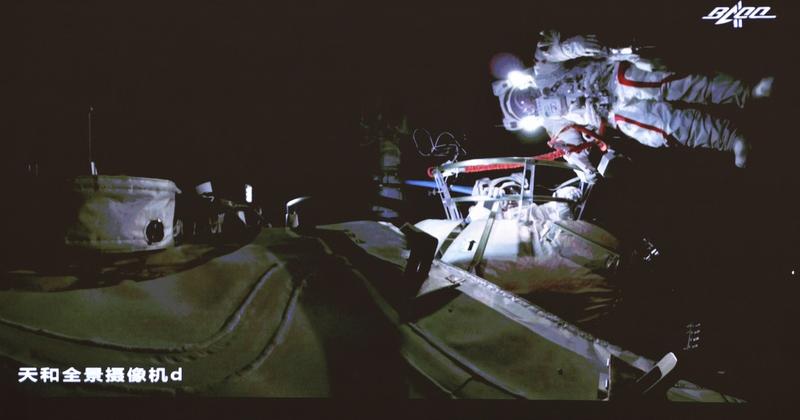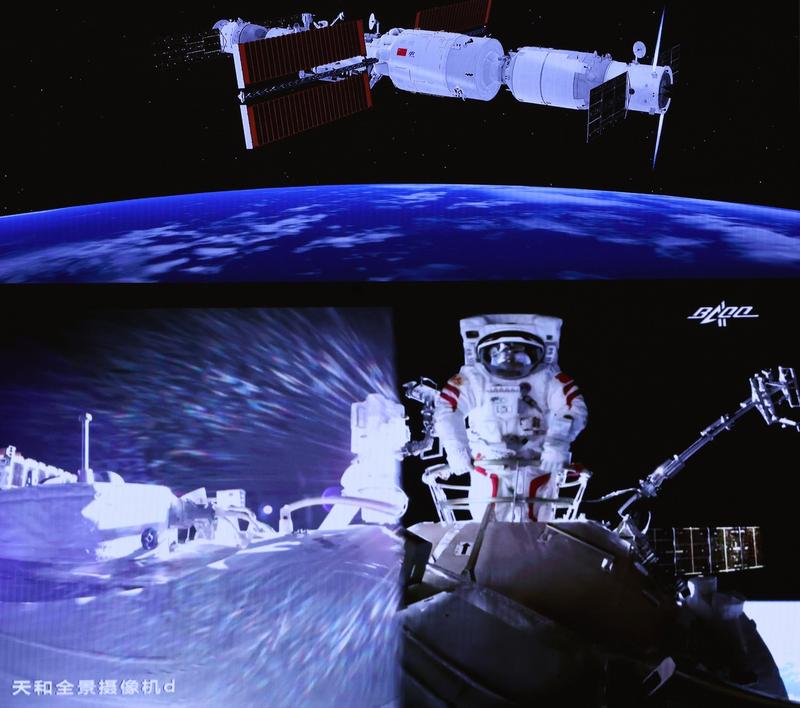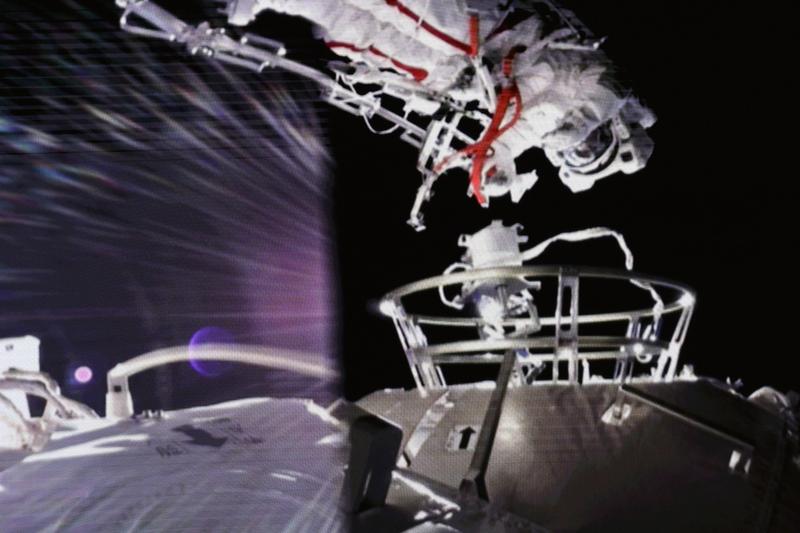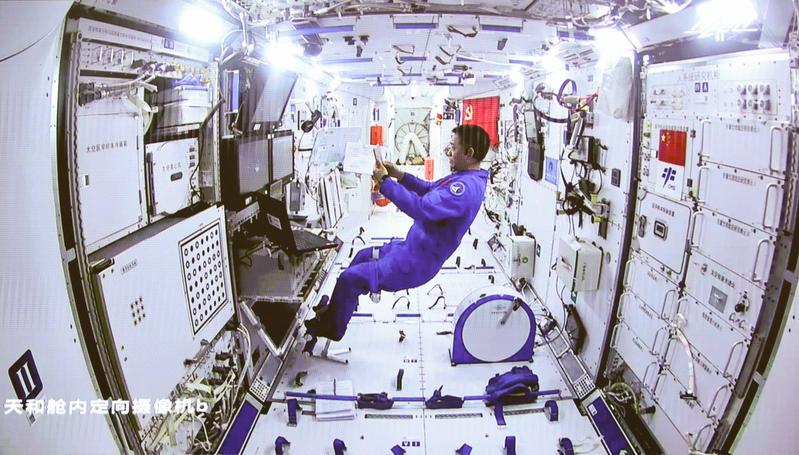 Chinese astronauts Major General Liu Boming and Senior Colonel Tang Hongbo are seen doing extravehicular activities (EVAs) out of the space station core module Tianhe on Sunday morning. (PHOTO / XINHUA)
Chinese astronauts Major General Liu Boming and Senior Colonel Tang Hongbo are seen doing extravehicular activities (EVAs) out of the space station core module Tianhe on Sunday morning. (PHOTO / XINHUA)
The Shenzhou XII mission crew engaged in China's first extravehicular activity in 13 years to perform about seven hours of work outside the core module of China's permanent space station.
After hours of preparations early Sunday morning, Major General Liu Boming floated out of the module, named Tianhe, or Harmony of Heavens, at 8:11 am to begin the challenging spacewalk as the module orbited Earth at an altitude of about 390 kilometers. Senior Colonel Tang Hongbo stayed in the air lock to assist Liu and then also emerged from the spacecraft at 11:02 am.
Wearing the nation's new-generation extravehicular suit, the pair conducted several sophisticated maneuvers such as testing a large robotic arm, installing equipment outside the spacecraft and adjusting the external panoramic camera.
During the spacewalk, Liu stood on, and moved with, the robotic arm for hours. Tang, in addition to assisting Liu and fulfilling his own assignments, also practiced the procedures for an emergency return into Tianhe.
 Chinese astronauts Major General Liu Boming and Senior Colonel Tang Hongbo are seen doing extravehicular activities (EVAs) out of the space station core module Tianhe on Sunday morning. (PHOTO / XINHUA)
Chinese astronauts Major General Liu Boming and Senior Colonel Tang Hongbo are seen doing extravehicular activities (EVAs) out of the space station core module Tianhe on Sunday morning. (PHOTO / XINHUA)
At the end of the seven-hour operation, Liu turned his head toward an external camera, waved his hand and said: "We want to thank all people in our science and technology communities involved in the spacewalk. We are also grateful for the great support of the Chinese people. Next, we will conduct another spacewalk. We will fly higher while the space station will become bigger."
The spacewalk finished at 2:57 pm, when the two astronauts closed the hatch after Liu returned into the module.
During the spacewalk, Major General Nie Haisheng, the mission commander, remained inside the module to instruct his peers on their tasks and monitor related equipment.
The entire operation was tracked and guided by the Beijing Aerospace Control Center in northwestern Beijing.
 Chinese astronauts Major General Liu Boming and Senior Colonel Tang Hongbo are seen doing extravehicular activities (EVAs) out of the space station core module Tianhe on Sunday morning. (PHOTO / XINHUA)
Chinese astronauts Major General Liu Boming and Senior Colonel Tang Hongbo are seen doing extravehicular activities (EVAs) out of the space station core module Tianhe on Sunday morning. (PHOTO / XINHUA)
Through the spacewalk, the astronauts verified the reliability and capability of hardware involved in extravehicular operation, demonstrated their adaptability and ability to work with the robotic arm, and examined the performance of their spacesuits. The operation laid a crucial foundation for subsequent spacewalks, according to the China Manned Space Agency.
As of Sunday afternoon, the three-member crew had flown with Tianhe-the first and central component of the Chinese space station, called Tiangong, or Heavenly Palace-for more than 17 days. They are scheduled to remain in space until mid-September, when they will return to Earth.
Their spaceship was launched on a Long March 2F carrier rocket that blasted off on June 17 from the Jiuquan Satellite Launch Center in northwestern China. The astronauts entered Tianhe later that day after the spacecraft docked with the module, becoming Tianhe's first inhabitants.
The Shenzhou XII mission, China's seventh manned spaceflight, is part of the Tiangong program, which aims to complete a three-component space station in a low-Earth orbit before the end of 2022.
 Chinese astronauts Major General Nie Haisheng, commander of the mission, is seen staying inside the module and assisting in manipulating the robotic arm that helps the other two astronauts with the extravehicular activities (EVAs). (PHOTO / XINHUA)
Chinese astronauts Major General Nie Haisheng, commander of the mission, is seen staying inside the module and assisting in manipulating the robotic arm that helps the other two astronauts with the extravehicular activities (EVAs). (PHOTO / XINHUA)
Before Sunday, Chinese astronauts had conducted only one other spacewalk-by Liu and Zhai Zhigang during the three-day Shenzhou VII mission in September 2008. Another crew member in that mission-Jing Haipeng-remained in their spacecraft to control and monitor equipment.
During the operation, Zhai stayed out of the spacecraft for about 15 minutes while Liu moved the upper half of his body out of the craft for several minutes to assist him.
Their short adventure made China the third nation, after the former Soviet Union and the United States, able to independently conduct a spacewalk.
According to Ji Qiming, assistant director of the China Manned Space Agency, the Shenzhou XII crew will make two lengthy spacewalks to use the robotic arm to install equipment and check the Tianhe module's external condition.
 Technical personnel work at Beijing Aerospace Control Center in Beijing, capital of China, on July 4, 2021. (PHOTO / XINHUA)
Technical personnel work at Beijing Aerospace Control Center in Beijing, capital of China, on July 4, 2021. (PHOTO / XINHUA)
Aside from the spacewalk, the robotic arm the astronauts used on Sunday was another highlight because it is the largest, strongest and most advanced apparatus of its kind ever built by China, according to Liang Changchun, a chief designer of the machine at the China Academy of Space Technology.
Fully extended, the robotic arm is 10.2 meters long, and it can handle payloads weighing up to 25 metric tons. It has seven motorized joints that allow it to act, to the greatest extent possible, like a human arm.
It is self-relocatable and can reach many parts of the module through an inchworm-like motion, Liang said.
The first person to ever go on a spacewalk was Alexei Leonov, of the Soviet Union, who stayed more than 12 minutes outside the Voskhod 2 spacecraft on March 18, 1965.
By now, 232 astronauts, mostly American and Russian, have made spacewalks.


